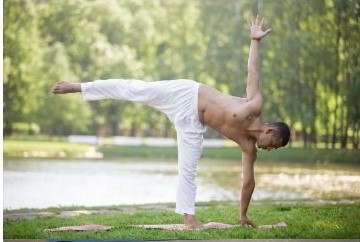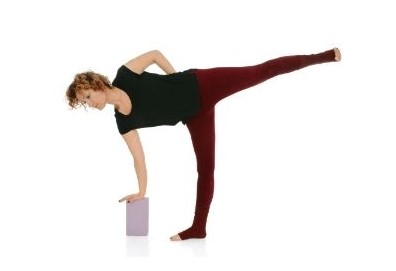Ardha Chandrasana – Half Moon Pose, How To Do, Benefits
By Dr Raghuram Y.S. MD (Ay) & Dr Manasa, B.A.M.S
In this pose the practitioner assumes the shape of half moon and hence the name. Chandra or moon is one of the energies of the nature other than Surya i.e. sun energy. The term also represents shining or hue of light. Half moon pose is a standing balancing pose. It is known to bestow strength and stability to leg and ankle. This pose has a strong impact on your chest and abdomen, thighs, ankles and spine. It is an intermediate pose because it demands balance of the body and coordination of the muscles to perform this pose.
Ardha = half
Chandra = moon
Asana = pose
In Shivananda Yoga, half moon pose is named as Anjaneyasana (used in Chandra Namaskar – Moon Salutation series). In Bikram Yoga, Ardha Chandrasana is the name given to Indudalasana, a two legged standing side bend.
Read – Health Benefits Of Yoga: Mind And Body

Table of Contents
Preparation for Ardha Chandrasana
- Ardha Chandrasana i.e. ‘half moon’ pose should be done on empty stomach, preferably early in the morning.
- Food should be consumed 3-4 hours before doing the asana if it is practiced at any other time of the day other than early morning. This will keep the stomach empty by the time one takes to the asana and also provides the necessary energy needed to perform the pose.
- One needs to keep their bowel and bladder empty while taking on to the pose.
Read – Sarvangasana – Shoulder Stand Pose, Method, Benefits, Dosha Effect
Method of doing Ardha Chandrasana
Positioning for the Asana
- Stand straight with feet kept at hips width apart.
- Breathe easily.
Performing and getting to the Ardha Chandrasana – half moon pose
- Placing your left foot out, step your right leg 1-2 feet forward (as if you are walking on your right leg with the left leg fixed).
- Rest your left hand on right waist or on your left hip. With this hand do not allow left hip to fall forward, instead keep it open.
- Keep the right leg bent at the knee as you inhale.
- Slowly lean on right leg keeping the knee bent and simultaneously start lifting your left leg into the air, towards the ceiling.
- If you are a beginner reach out to the block in front of you and place right hand on it pressing it. Keep slowly lifting your left leg up. At the same time straighten your right leg at the knee. Engage your right quads and knee.
- Keep left leg active by stretching your toes in. Using left hand placed on left hip as lever, allow opening of your chest, shoulders and hips.
- Now if you feel that you are balanced, slowly release left hand from the left hip and slowly rise it up in the air, the fingers stretched upwards and facing the ceiling. Now both your left hand facing up and right hand facing down and resting on the block are in one straight line.
- Keep the head neutral and in line with your torso. Keep your neck elongated. Don’t lift your head up.
- Balance by keeping both legs active and opening up the pelvis.
- Once you have found your balance and are comfortable in this pose, you can come further down on your right hand by lowering the block from vertical to horizontal position.
- If you are still comfortable or gain control with practice, you can remove the block and challenge yourself further and reach the floor with your right hand. Place your right hand or fingers touching the ground. Now you are balanced well on your right foot and hand while your torso and left leg are parallel to the floor and looks as if they are resting on your right leg and hand.
- Now further press your right hand to the floor to regulate your balance. Lift the inner ankle of the right foot strongly upward as if you are drawing energy from the floor into the right groin. Press the sacrum and scapulae firmly against the back torso. Lengthen the coccyx towards the left heel.
- Keep breathing easily.
- Be here for 4-5 breaths or for 30-60 seconds. Slowly drop your left hand and bring it on your left waist / hip.
Release from the asana
- Bend the right leg at the knee.
- Lift your right arm off the floor while you lower the left leg to the floor with exhalation and with a gentle lift come back slowly to the standing position.
- Relax and breathe freely for few counts.
- Repeat the steps on left side.
Variations of the pose
Parivrtta Ardha Chandrasana – Revolved Half Moon Pose – in this, the body is revolved towards the standing leg.
Baddha Parivrtta Ardha Chandrasana – Bound Revolved Half Moon Pose – in this the body is revolved towards the standing leg with arms bound around the standing leg. (read more)
Health Benefits
- Strengthens the spine, butts, thighs, ankles and abdomen
- Strengthens your abdominal muscles
- Good for the joints and muscles around the spine
- Stretches shoulders, chest and spine
- Aligns shoulders
- Keeps thighbones strong
- Opens hips, chest and heart
- Stretches the groins, hamstrings and calves
- Strengthens the legs and ankles and helps in improving the balance.
- Good remedy for backache
- Removes stiffness in the lower back and tones the sacroiliac region
- Improves digestion
- Helps in relieving stress and anxiety
- Removes fatigue
- It enhances awareness and you become aware of your body
- Improves balance and coordination to a great extent
Helps in curing the below mentioned conditions –
- Backache
- Sciatica
- Osteoporosis
- Indigestion
- Gastritis
- Constipation
- Menstrual pain and cramps
- Fatigue
- Anxiety
Benefits on muscle groups
Half moon pose benefits the below mentioned muscles –
- Biceps
- Triceps
- Core – abs
- Hamstrings
- Hips
- Quadriceps
- Psoas
Therefore this pose can be included in yoga sequences wherein these muscles are involved.
Read – Upavistha Konasana – How to do, Health Benefits, Precautions
Spiritual and energetic benefits
The Yogis become aware of both half of their bodies with constant practice of this pose. The right half of our body represents the sun energy and masculine energy. Similarly the left half of the body represents the moon energy and feminine energy. The combination and balance of both these energies make up the body-mind complex and this pose helps the Yogis to become aware of this. To bring balance both physically and mentally, these energies should be balanced by the opposite positive energies.
Just as the half moon reveals a perfect balance between the moon and the sun, the half moon pose balances the body with lateral extension of the leg and torso. It is also said that half moon pose is the only pose of Hatha Yoga school (Ha = Sun and Tha = Moon) that brings out both sun and moon (male and female) energies. The other half of the half moon is considered as half sun. Therefore the half moon pose brings a balance between both the energies i.e. hot and cold energies. This will eventually establish health in the body in a comprehensive way and keeps the functions balanced.
In this pose the lunar energies are channelized. The movement of the torso towards the floor engages a balance with cool mind. This depicts the features of the moon.
Read – Hatha Yoga and Shat Karmas: Benefits, Precautions
Preparatory Pose
- Baddha Konasana – Bound Angle Pose
- Supta Baddha Konasana – Reclining Bound Angel Pose
- Supta Virasana – Reclining Hero Pose
- Supta Padangusthasana – Reclining Hand-to-big toe Pose
- Uttanasana – Standing Forward Bend Pose
- Prasarita Padottanasana – Wide Legged Forward Bend
- Utthita Parsvakonasana – Extended Side Angle Pose
- Utthita Parsvottanasana – Intense Side Stretch Pose
- Vrkshasana – The Tree Pose
- Virasana – Hero Pose
- Utthita Trikonasana – Extended Triangle Pose
- Surya Namaskar – Sun Salutation
- Parsvottanasana – Intense side stretch pose
- Virabhadrasana I – Warrior Pose I
Follow Up Poses
- Prasarita Padottanasana – Wide legged forward bend pose
- Parsvottanasana – Intense side stretch pose
- Parivrtta Trikonasana – Revolved Triangle Pose
Related Video
Watch this video to follow the method of doing Ardha Chandrasana
https://www.youtube.com/watch?v=SbkhsRXCmfc
Modifications
It is a difficult pose to begin with especially if you are a beginner. You may feel problems with balancing in the pose. You may use the wall for support in that case.
Stand with your back to the wall, one leg’s length away from the wall. Exhale and bend forward into a standing forward bend. Inhale and slowly raise left leg parallel to the floor and press the left sole against the wall. Let your toes be turned toward the floor. Again exhale. Now rotate your torso to the left. At the same time turn left leg and foot until your inner foot is parallel to the floor. Now rest your left hand on left hip. You will be able to balance yourself with the pressure of the raised heel pressed against the wall. You may also perform this pose with your back to and leaning against the wall.
The pose is also entered from triangle pose.

Time spent doing Ardha Chandrasana?
Be in the pose for 4-5 breaths or for 30-60 seconds. You need to perform the pose for the same duration even on the opposite side.
Impact on Chakras
Ardha Chandrasana stimulates and balances the sacral chakra and root chakra.
Contraindications, Precautions
Patients suffering from below mentioned conditions should avoid doing Ardha Chandrasana –
- Headache
- Migraine
- Low blood pressure
- Diarrhea
- Insomnia
- Injury to your legs, hips, shoulders or back
- Hamstring tear
- Eyestrain
- Varicose veins
- Back or shoulder injury
- Weak knees and legs
Caution
Make sure not to turn your head to look upwards if you have neck problems. Just continue to gaze straight ahead and keep both sides of the neck elongated evenly. Let the head and neck is neutral.
Elderly and pregnant women should practice this pose by leaning against the wall.
Impact of Ardha Chandrasana on doshas and tissues
Impact on Doshas and its subtypes – Since the half moon pose helps in improving digestion it balances samana vata, pachaka pitta and kledaka kapha. This is also supported by the fact that this pose helps in getting rid of gastritis and indigestion. Since it helps in relieving stress and anxiety and enhances awareness about self, it is good for balance of functions of prana vata, sadhaka pitta and tarpaka kapha and their mutual balance. Since it helps in improving balance and coordination of the body and relieves fatigue it is beneficial for balancing vyana vata functions. Since it opens up chest and heart it is good for balancing udana vata and avalambaka kapha. As the pose helps in recovering from menstrual pain and cramps and also relieves constipation, the pose balances apana vata functions. These functions are also put into balance as the pose balances the functions of root and sacral chakra.
Impact on tissues – Half Moon Pose strengthens and stretches the muscles and spine and improves the flexibility therein. It also strengthens the bones. Therefore the pose is good for muscles and bone tissue and also for the channels transporting these tissues in the body.
Click to Consult Dr Raghuram Y.S. MD (Ayu)









